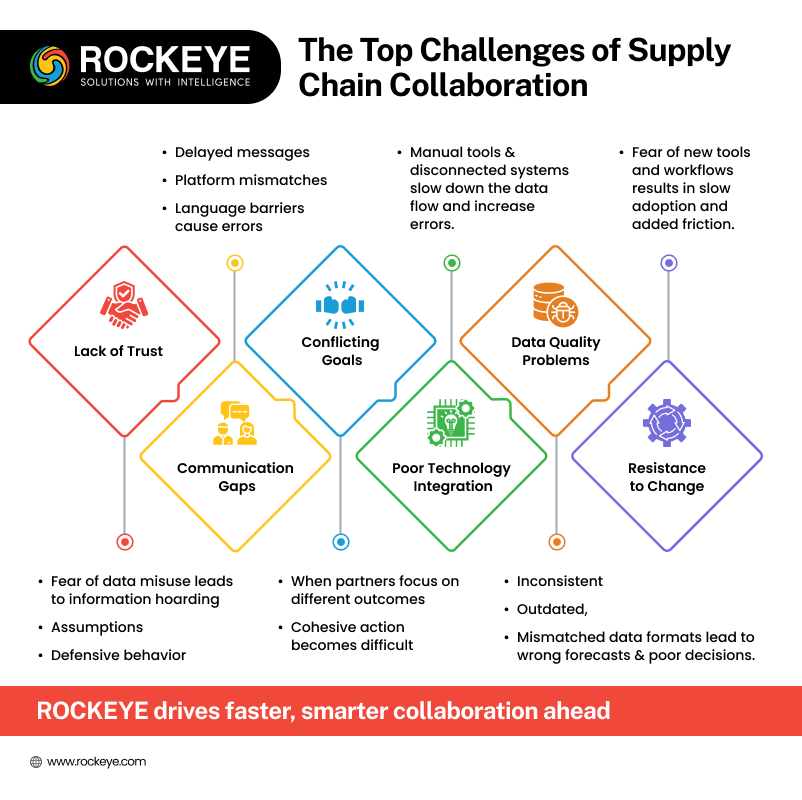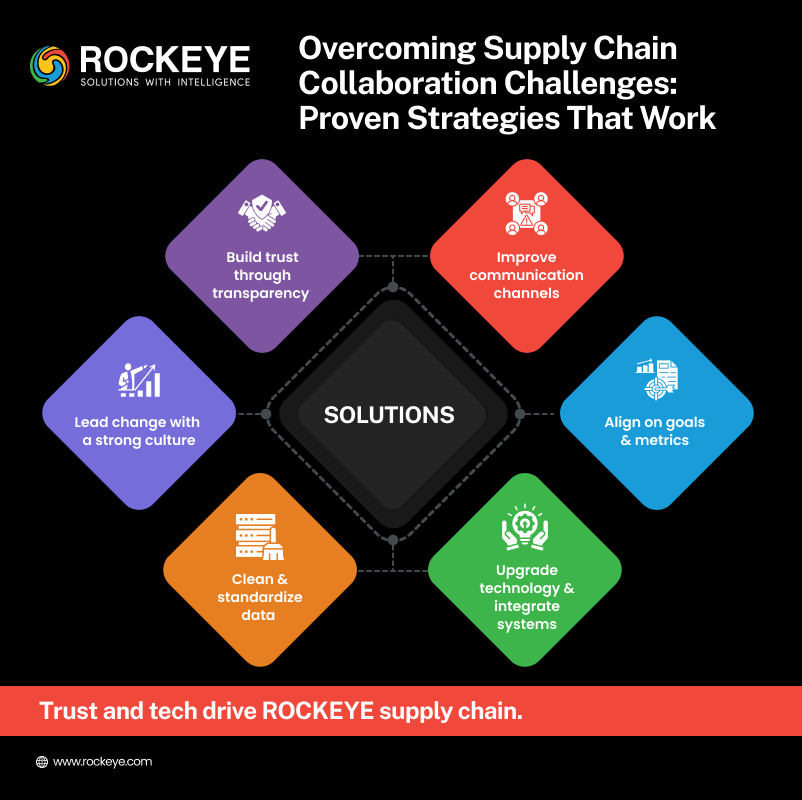Summary:-
Through effective supply chain collaboration, companies can shorten response times, reduce costs, and build resilience. But despite all these, the lack of trust, poor communication, misaligned objectives, outdated technology, and inferior quality of data keeps many businesses away from reaping those benefits. To address such challenges, it requires practices that are some sort of, shared objectives, and up-to-date digital tools. Good leadership and a comprehensive system are core to enhancing collaboration on the entire supply chain. With proper measures in place, companies should be able to develop agile and reliable partnerships.
Introduction
Supply chain collaboration has become necessary. Companies need each other in the competitive global environment to share data and align operations. They enjoy better speed, lower costs, and a higher level of resilience in their businesses with proper collaboration. According to the source, businesses with better collaboration enjoy better results than others in the same industry.
However, it’s not easy.
Businesses have to face several challenges that can affect the overall collaboration.
These challenges make it hard to build trust and coordinate activities. In this blog, you will explore the key challenges of supply chain collaboration and discover practical solutions to overcome them.
What Is Supply Chain Collaboration?
It happens when two or more companies work together.
They plan and execute things together. Additionally, they manage their supply chain activities effectively. This includes several parties-
- Suppliers
- Manufacturers
- Logistics providers
- Distributors
- Retailers
They share several things with each other, such as –
- Forecast data
- Inventory levels
- Delivery schedules
- Production planning
- Quality standards
The main goal is to create a seamless chain where each partner can adapt and respond to market demands faster.
Why It Matters?
Supply chain collaboration brings powerful benefits. Here’s why it’s worth the effort:
Stronger relationships: Trust grows with shared success.
- Better visibility: Real-time data means better decisions.
- Lower costs: Shared resources reduce waste.
- Improved efficiency: Less duplication, fewer delays.
- Faster response times: Partners react quickly to market changes.
- Greater innovation: Teams share ideas and solve problems together.
The Top Challenges of Supply Chain Collaboration

Have a look at the main issues that stop companies from collaborating effectively:
1. Lack of Trust
It is the basic foundation of collaboration. Yet, it is missing in supply chain relationships. There are many companies that fear that the shared data can be used against them in some future event. So, they worry about losing their edge in their target industry.
This leads to many things:
- Withholding information
- Second-guessing
- Delayed responses
In industries where competition is tight, partners hesitate to be transparent on different occasions. Without trust, the teams cannot cooperate openly. They may work defensively rather than collaboratively. It remains one of the hardest challenges of supply chain collaboration to solve.
2. Communication Gaps
Clear and timely communication is key to supply chain success. But in many networks, messages are delayed, misinterpreted, or lost entirely. Also, companies use different platforms, which further makes real-time discussion challenging. On top of this, cultural and language differences can add more confusion. Sometimes teams rely a lot on email, which further slows decision-making process in the companies.
A lack of defined contact points leads to more confusion in all aspects. Miscommunication leads to missed deadlines and costly errors. It also weakens trust between partners. Without structured communication protocols, supply chains fall apart. Fixing this issue is critical to reducing friction and improving flow.
3. Conflicting Goals
All the companies in the supply chain have different priorities. One business might be focused on cost-cutting, while another is trying to improve delivery speed. A third might focus on premium quality. These goals don’t always align. When each party follows its own agenda, it creates friction. Also, the conflicts over these priorities can delay decisions and cause frustration. Besides this, it results in uneven service quality for customers.
Partners struggle to work together in harmony without shared objectives. So, alignment is essential. All parties need to understand what success looks like together. Otherwise, collaboration becomes a tug-of-war rather than a partnership.
4. Poor Technology Integration
One of the biggest challenges of supply chain collaboration is outdated or incompatible technology. Many companies still rely on manual tools like Excel and email. These tools can’t keep up with today’s fast-paced operations. There are several consequences when the systems are not integrated properly, like:
- Data flows slowly or gets lost
- Errors increase
- Teams waste time chasing updates or re-entering data
This creates delays and uncertainty. In modern supply chains, speed and accuracy matter. Visibility suffers without proper automation and integration. Partners can’t respond to changes or make informed decisions quickly.
5. Data Quality Problems
Even if companies are willing to share data, it must be:
- Clean
- Accurate
- Consistent
Many supply chains suffer from poor data quality, which includes:
- Missing entries
- Outdated records
- Inconsistent formats
There is a lot of confusion if one partner lists inventory in units and another in pallets. Duplicate records or inaccurate forecasts can lead to stockouts or overproduction. Bad data undermines trust. It causes poor decisions and slows reaction times. So, all the data must follow certain standards. Also, it should be validated and maintained on a regular basis. Collaboration becomes a guesswork without quality data.
6. Resistance to Change
Many employees resist change, especially when it changes the ongoing and familiar workflows. Teams may worry about losing control, job security, or being forced to adopt tools they don’t understand. This fear slows the adoption of new systems and processes. Also, it creates tension between leadership and frontline staff.
In supply chain operations, delays can slow the overall progress. Also, the shift in elements brings added workloads and learning curves. So, leaders must manage resistance carefully. They should involve staff early, offer training, and explain the benefits.
How to Overcome These Challenges?

The good news? These barriers are not impossible to break. Below are proven ways to overcome each challenge.
1. Build Trust Through Transparency
Start small. Choose pilot projects to show value.
- Share only necessary data at first.
- Set clear boundaries and roles.
- Hold joint performance reviews.
Also, use contracts and service-level agreements (SLAs) to reduce risk. Trust grows with consistent results.
2. Improve Communication Channels
Good communication tools make a big difference. Here are some ways to improve it.
- Use shared dashboards and platforms.
- Set up regular check-ins or virtual standups.
- Assign single points of contact in each team.
Also, invest in training to improve soft skills and cross-cultural communication.
3. Align on Goals and Metrics
Sit down with your partners. Discuss each other’s goals. Then, find a shared vision.
- Define common KPIs (Key Performance Indicators).
- Agree on how success will be measured.
- Create joint action plans with mutual benefits.
When everyone moves in the same direction, collaboration gets easier.
4. Upgrade Technology and Integrate Systems
Modern supply chains rely on real-time data. That means investing in:
- Cloud-based ERP systems
- Internet of Things (IoT) sensors
- Blockchain for transparency
- API integrations for faster data exchange
You have to opt for the tools that work well with your partners’ systems. Automation also reduces manual errors and saves time.
5. Clean and Standardize Data
Data management is key. Here are some tips for it.
- Use data validation tools.
- Clean data regularly.
- Set data standards across partners.
You can also appoint a data manager to oversee consistency.
6. Lead Change with a Strong Culture
Leadership must support collaboration. Change starts from the top.
- Communicate the benefits of collaboration.
- Offer training and support.
- Recognize and reward collaborative behavior.
Other Barriers Worth Nothing
The above-mentioned challenges are the major ones. However, there are some other challenges that can affect collaboration:
- Legal and compliance issues- Sharing the supply chain data can lead to a violation of regional privacy laws or industry-specific regulations. So, companies should balance transparency with legal obligations to avoid penalties.
- Supply chain disruptions- There are several unexpected events that can lead to delays and shortages. These events test the strength of relationships and expose the weak links in collaborative planning systems.
- Language barriers- In global supply chains, language differences can lead to misinterpretation of emails, instructions, or documents. This leads to missed deadlines and errors. So, companies should invest in multilingual communication systems.
Best Practices to Encourage Collaboration
Here are some simple but powerful ways to create better collaboration in your supply chain:
Conduct Regular Reviews
Meet quarterly or monthly with key partners. Discuss:
- What’s working
- What’s not
- How to improve
Use Collaborative Planning Tools
Try CPFR (Collaborative Planning, Forecasting, and Replenishment) methods to:
- Share demand forecasts
- Coordinate production schedules
- Avoid overstock or understock
Encourage Co-Innovation
Invite partners to contribute ideas. Co-develop products or solutions. This increases engagement and strengthens relationships.
Create Shared Risk Reward Models
If everyone gains (or loses) together, they will work better together.
- Offer bonuses for hitting shared goals
- Split cost savings fairly
- Share costs of new tech upgrades
The Bottom Line
The challenges of supply chain collaboration can’t be ignored. These can slow down the progress of your business. However, you can solve them for better results. It takes leadership, technology, communication, and commitment. You have to improve the level of collaboration in the supply chain to future-proof your business. It is the backbone of supply chain success. ROCKEYE has a solid suite of tools that can help in improving supply chain collaboration.

FAQs
Q1. What are the biggest challenges of supply chain collaboration?
The biggest challenges of supply chain collaboration include lack of trust, poor communication, conflicting goals, data quality issues, outdated technology, and resistance to change. These issues can cause delays, increase costs, and damage relationships.
Q2. How can companies build trust with supply chain partners?
Trust starts with transparency and consistency. Companies should:
- Share accurate data
- Honor commitments
- Create win-win agreements
Long-term partnerships and clear expectations also help strengthen mutual confidence.
Q3. Why is technology important for collaboration in the supply chain?
Modern collaboration relies on integrated systems that provide real-time visibility, automate workflows, and reduce manual errors. Without the right tech, communication slows and decisions are based on outdated or incomplete information.
Q4. How do geopolitical risks affect supply chain collaboration?
Trade restrictions, sanctions, and political instability can break links between global partners. These risks require companies to diversify suppliers, monitor global events, and create flexible contingency plans.

